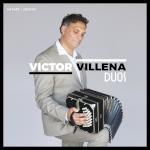Tango is one of those genres of folk music whose character and popularity have spread its art throughout the world. Its chronological and geographical origins are dated back to the 19th century in the South American area known as Río de la Plata (River Plate, or La Plata River, in English), the region around the Atlantic estuary shared by Uruguay (north riverside) and Argentina (south), and their respective capitals, Montevideo and Buenos Aires. Two centuries ago, it was a crossroads of peoples & cultures: former settlers (in those days they have just achieved their independence from Spain), African slaves, new European immigrants, still many of them from Spain, but now even more from Italy, …
But the precise musical background from which tango originated and developed in Río de la Plata is obscure and probably misleading. There are also records of 19th and early 20th-century tango styles in Cuba and Spain, while there is even a flamenco tango dance that may share a common ancestor in a minuet-style European dance. One of the ancestors of tango is the milonga, a style of music from the Argentine, Uruguayan and Brazilian countryside. But all sources about tango Rioplatense stress the influence of African communities and their rhythms, while the instruments and techniques brought in by European immigrants in the 20th century played a major role in the style's final definition.
Last century’s tradition showed tango orchestras as played on a solo guitar, guitar duo, or an ensemble, known as the orquesta típica, which includes at least two violins, flute, piano, double bass, and at least two bandoneons. The bandoneon was one of the key final contributions that came from Europe for the construction of tango tradition. Named after the German instrument dealer Heinrich Band (1821–1860), it was originally intended as an instrument for religious and popular music of the day, in contrast to its predecessor, German concertina (Konzertina), which had predominantly been used in folk music.
Around 1870, German and Italian emigrants and sailors brought the instrument to Argentina, where it was adopted into the nascent genre of tango music. The Argentinian bandleader, composer, arranger, and tango performer Aníbal Troilo (1914-1975) was a leading proponent of the bandoneon. The other iconic artist of the instrument was Ástor Piazzolla (1921-1992) who played and arranged in Troilo's orquestra.

Victor Hugo Villena born in Argentina in 1979, began studying the bandoneon at the age of 9 in the suburbs of Buenos Aires. At 17, he was elected “bandoneonist of revelation” by the National Tango Academy of Buenos Aires. He won the Best Soloist Prize at the Argentina National Competition in 1997. In 1999, he left Argentina to settle in France. He performed as a soloist with the Orchester Philarmonique de Radio France, the Orchester symphonique des Pays de la Loire, the Moritzburg Festival Orchestra (Germany), the Stockholm Jazz Orchestra (Sweden), the Brussels Jazz Orchestra (Belgium).
His talent allowed him to perform on the biggest stages in France and around the world (Hollywood, Broadway, London, Tokyo). From 2003 to 2007, he was part of the world tour of the Gotan Project, a legendary electronic music group. In July 2007, Victor conducted the Opera María de Buenos Aires, performed at the National Theater of Lisbon. Between 2013-2018, he was the official bandoneonist of the singer and actress Ute Lemper with whom he toured in the main venues of the world: Phillarmonie de Paris, Frankfurt Opera, Royal Albert Hall. In 2018 he formed a duo with the French guitarist Emmanuel Rossfelder with whom he performed notably in the "Folles jours" of Nantes, Russia, Japan and Poland.
In 2020, Villena has published his CD ‘(Bandoneon) Duos’ (Duets), twelve songs (not only tangos) each of them performed by Victor and one of his ten guest artists. The melancholic ‘Agua e Vinho’ (by the Brazilian Egberto Gismonti), with E. Rossfelder. The tango ‘Eramos tan jóvenes’ (We were so young. L. Federico), with the cello of the Henri Demaquette. The beautiful ‘Milonga’ (by Jorge Cardoso), with E. Rossfelder. ‘Largo’ (Long) an excerpt from the Sonata BWV1017 in C minor (J.S. Bach), played with the French-Italian Sabrina Condello (violon). Another Argentine rural rhythm, ‘Chacarera’, written & performed in the guitar by Lautaro Tissera Favarolo (Buenos Aires, 1980).
The shady & nostalgic ‘Canción de cuna para una madre’, written & played on the piano by Barbara Varassi Pega (Rosario, Arg., 1977). The classic tango ‘Trenzas’ (by A. Pontier, H. Exposito), with the voice of Cristina Vilallonga. ‘Umeboshi’ (A. Politti), with the guitar of Kay Sleking. One of the most iconic classic tangos, ‘La Cumparsita’ (G. Matos Rodríguez, 1987-1948), arranged by G. Beytelmann, with S. Condello (violon). ‘Tercermundo’, composed & played in the piano by Fernando Otero (B. Aires, 1972). ‘Cuerdas con Fuelle’ (A. Schwarz), performed with Pavadita Strings Quartet. And the closing piece, ‘Allegro’ from the Sonata N.1 in G-minor (G.F. Haendel), played together with 1721 Project.
'Duos' is a magnificent example of the possibilities of the bandoneon to merge into other musical styles, beyond the traditional 'rioplatenses', when it is performed with absolute talent by an artist like Victor Villena.
Photo Credits:
(1)-(2) Victor Villena
(unknown/website).